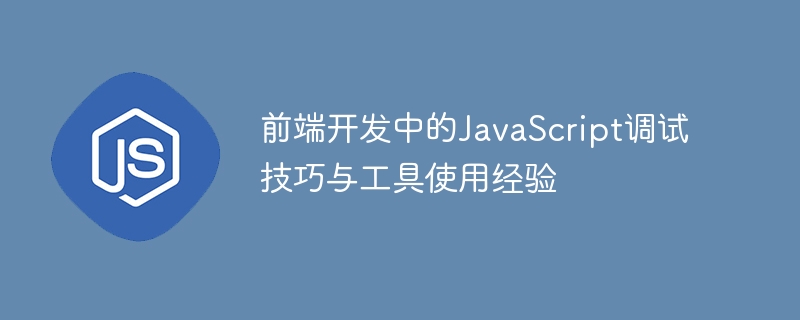

JavaScript debugging skills and tool usage experience in front-end development
Overview:
In front-end development, JavaScript is often an essential technology. However, due to the flexibility and complexity of JavaScript, various bugs and problems often occur during development, making debugging a very important task. This article will introduce some common JavaScript debugging techniques and tool usage experience to help developers solve problems more efficiently.
1. Use console.log for basic debugging
Console.log is one of the most common debugging tools in JavaScript and can output debugging information to the browser's console. Insert the console.log statement in the code to view variable values, function execution results and other information to locate the problem. For example:
var name = "John"; console.log(name);
will output "John" in the console.
2. Use breakpoints for debugging
Most modern browsers have built-in debugging tools. You can pause execution by setting breakpoints in the code, and view variable values, execution status, etc. at the breakpoints. . Open the debugging tool by opening the "Inspect" function via F12 or right-clicking on the web page. Click on the left side of the line of code that needs to be debugged to set a breakpoint.
var total = 0;
for(var i=1; i<=10; i++){
total += i;
console.log(total);
}After setting a breakpoint, the code execution will pause when it reaches the breakpoint, and you can view the value of the variable line by line.
3. Use debugger statements for debugging
In addition to setting breakpoints in debugging tools, JavaScript also provides a special statement debugger that can be inserted directly into the code to achieve similar effects. When the code is executed to the debugger statement, it will automatically pause and open the debugging tool. For example:
var age = 20; debugger; console.log(age);
The code after the debugger statement will be executed in the debugging tool.
4. Use try-catch for exception handling
try-catch is an exception handling mechanism in JavaScript that can capture and handle exceptions thrown during code execution. By using try-catch statements in code blocks, exceptions can be caught and handled to avoid program interruption. For example:
try {
var total = 10 / 0;
} catch (e) {
console.log("发生异常:" + e.message);
}When an exception occurs when the code is executed, it will be captured by the catch statement and the corresponding processing code will be executed.
5. Use browser compatibility tools for debugging
In front-end development, different browsers have different support for JavaScript, which often causes code problems in some browsers. In order to solve this problem, you can use some browser compatibility tools, such as Can I use, Browserstack, etc., to test the code compatibility under different browsers and find out the problem.
6. Use third-party debugging tools
In addition to the built-in debugging tools in the browser, there are many third-party debugging tools that can be used. Common ones include Chrome DevTools, Firebug, VSCode, etc. These tools provide more functions and debugging options, such as performance analysis, network monitoring, etc., which can help developers debug JavaScript code more comprehensively.
Conclusion:
In front-end development, JavaScript debugging is a very important link. By using console.log, breakpoint debugging, try-catch exception handling, browser compatibility tools, and third-party debugging tools, developers can locate and solve problems more efficiently. I hope that the debugging skills and tool usage experience introduced in this article can help readers better debug JavaScript in front-end development.
The above is the detailed content of JavaScript debugging skills and tool usage experience in front-end development. For more information, please follow other related articles on the PHP Chinese website!